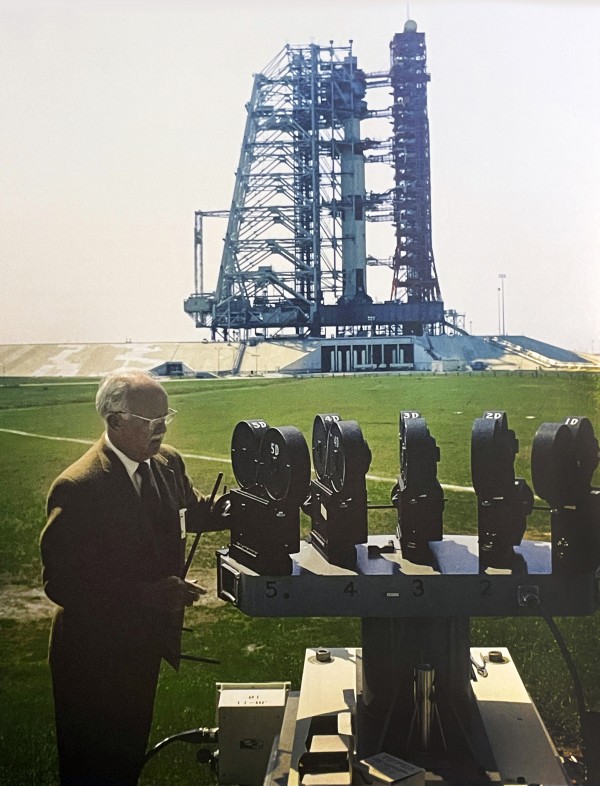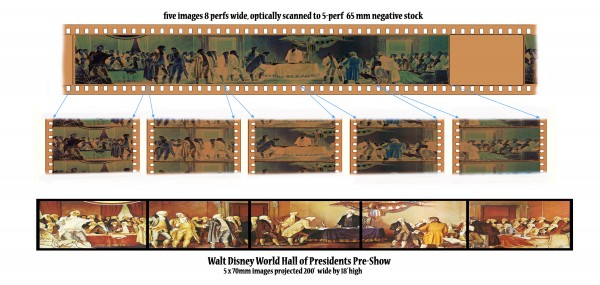A process for filming large-scale paintings on a vertical animation stand using a single 48-perforation-wide horizontal VistaVision image. This extra-wide image was optically printed to five separate 70mm images for projection.
Film Explorer

The film components of the Hall of Presidents attraction were photographed on one strip of 35mm film running horizontally in the camera. The frame was 40-perforations wide, and the film was advanced 48-perforations at a time, leaving a blank area of 8-perforations between each frame.
Design by Christian Zavanaiu.

The 40-perforation-wide camera frame was reformatted across five 70mm film prints to create an ultra-wide wraparound image with an aspect ratio of 11:1.
Design by Christian Zavanaiu.
Identification
5 images, each 48.56 mm x 22.09 mm (1.912 in x 0.87 in).
Eastman color print stock.
Standard Eastman Kodak edge coding.
Cellulose triacetate safety film until the 1980s, followed by polyester base prints until 2010.
5
Consistent color was maintained by photographing each painting in a single image on one negative. However, care had to be taken when optically separating this negative onto five 70mm prints. Screen-to-screen color accuracy was necessary to maintain the illusion of a seamless and continuous image. Technicolor Laboratories used their precise developing and printing standards that had been developed earlier for other Disney multi-screen presentations, such as the Circle-Vision process.
None
Separate playback on 35mm full-coat magnetic track synchronized to projectors.
226.2 mm x 25.17 mm (8.920 in x 0.722 in).
Eastman color negative.
Standard Eastman Kodak edge coding.
History
The Hall of Presidents at Walt Disney World in Orlando, Florida, was a creative follow-up to “Great Moments with Mister Lincoln”, a popular exhibit at the 1964 New York World’s Fair in which a stunningly lifelike Audio Animatronic figure of Abraham Lincoln rose from his chair to give a speech. Walt Disney intended to expand that concept to include all the presidents. The first part of the Hall of Presidents show was a lengthy narrative in the form of a widescreen film presentation utilizing large panoramic paintings to illustrate key moments in America’s early history projected on a huge curved screen, 200 ft wide and 18 ft high (70m x 5.5m). A dozen artists had been commissioned to create the 85 paintings needed, some of their art reaching 40 ft (12.2m) wide.
A new photographic system had to be created to capture all the nuances of the complex movements of the painting and camera in a single, very wide image. After some experimentation, Disney engineer Ub Iwerks came up with a way to film each piece of art on a vertical animation stand that could move the paintings up and down and from side to side. Additional movement was accomplished with an overhead camera rig mounted on dual tracks 30 ft (9.1m) long that could truck in and out, in order to create combination “zoom and pan” type moves across the paintings. Later, that single image would be separated into the five elements for projection. The entire filming system and the animated movements were programmed using a punched paper tape with photoelectric sensor, similar to that used at the time to control optical printers
For the first 12 minutes of the presentation, the original show depicted paintings across only three of the screens. During the Abraham Lincoln/Civil War section of the narrative, the images then expanded outwards across the outer two screens for the remainder of the filmed portion of the show. The last five-screen image was a live-action launch of the Apollo 13 Saturn rocket, filmed using the same baseplate and five camera set-up, with 135mm telephoto lenses, as was used for some scenes in Circle-Vision 200 productions. The addition of anamorphic adaptors gave each frame a slight squeeze (x 1.5) in order to fill out the images within the 70 mm frames. In later versions, a launch of the Space Shuttle replaced the Saturn rocket footage. At the conclusion of the film section, the middle three screens rose up to reveal the Audio Animatronic (AA) presidents on stage.
The original attraction premiered October 1, 1971. Walt Disney, who had taken a keen personal interest in American history, passed away in 1966 so he never got to see it. The Hall of Presidents was a unique, one-of-a-kind attraction that was presented continuously in this format until it was thoroughly revised in 1993. At that time an entirely new narrative and paintings were shot, to reflect the views of Eric Foner, a historian who convinced Disney Chairman Michael Eisner to more directly address sensitive cultural issues such as the lasting effects of slavery. Through the years, additional AA presidents were added, necessitating changes to the timing and narration. Around 2010, the entire filmed portion of the film was revamped into a seamless digital presentation with no more mullions dividing the screens.
A similar large-format capture system was used for the Energy Pavilion Pre-Show at EPCOT (at Walt Disney World in Florida) in 1982 in which a multi-plane cel animation was photographed on a VistaVision camera modified to 24-perforations wide. Again, there was the need to film complex camera moves on an animation stand onto a single image that could later be optically divided into three 70 mm prints for projection of the four-minute prologue to the main show.
Selected Filmography
Technology
There have been many multi-screen presentations in the history of cinema, sometimes synchronized with live performers such as hosts or musicians in a theater, but mixing together Audio Animatronics characters with a five-screen 70 mm film presentation had never been attempted before. Making everything much more complex was the need to animate very large paintings across consecutive screens. The initial challenge was how to synchronize the movements of all five parts of each painting at the same time. Could a single camera photograph individual sections as five separate passes and still remain in sync? After some failed attempts, Ub Iwerks determined that the camera needed to capture the entire painting as a single image all at once. He and engineer Bob Otto, with the help of Roger Broggie in the Studio Machine Shop, specially modified a VistaVision camera. Normally 35mm film ran horizontally through the camera’s aperture in an 8-perforation configuration. For the Hall of Presidents, the camera needed to capture a continuous image 48 perforations wide. Another innovation involved using vacuum pressure to hold the large piece of film flush against the back plate during each exposure, then releasing the pressure, advancing the film, then reapplying the vacuum for the next frame. A spring-loaded rail at the top of the frame acted as an edge guide, applying downward pressure into the bottom rail guide. A clutch on the continuously running motor drove the sprocket, applying a constant lateral pressure. Despite not using conventional registration pins, the resulting images were very steady. A viewfinder was built on top of the camera to allow the operator of the rig to view any individual section by sliding the unit to five indexed positions. To adequately cover such an extremely large negative, a long focal-length lens from an 8 in x 10 in (20.3cm x 25,4cm) copy camera was used to ensure maximum sharpness across the entire aperture.
During the stop-motion photography it was decided to leave a large clear frame between images, so one 8-perforation section was deliberately left blank as an easily identifiable demarcation for the editor. This meant that the useful image was actually 40-perforations wide – one of the widest motion picture film formats ever created.
The resulting single image was divided into five 8-perforation sections using a special optical printer in order to create five 65mm interpositives from which duplicate negatives could be made for each screen. An intermediate step in post-production involved creating smaller 35mm workprints for editing and test screenings, but the main workflow of the project was an ultra-wide VistaVision image converted into five 70mm prints for interlocked projection. Custom continuous-loop cabinets, two stories high, fed the five Ballentyne projectors on the second floor of the theater and operated automatically without need for human intervention. As with Circle-Vision productions, 9-inch-wide (22.9cm) black mullions separated each of the curved screens in the theater, which helped mask any slight projector weave, or possible overlap between the five projected images.
References
Iwerks, Don (2019). Walt Disney’s Ultimate Inventor, the Genius of Ub Iwerks, pp. 186–194. Glendale, CA: Disney Publishing Group.
Iwerks, Don (2023). Personal interview by Jeff Blyth with Garry Broggie. Ojai, California (September 6).
Patents
A patent for the Hall of Presidents 48-perforation camera was applied for, however, final registration of the patent was not completed due to the death of inventor Ub Iwerks on July 7, 1971.
Preceded by
Compare
Related entries
Author
Jeff Blyth is a filmmaker who has made several Circle-Vision 360 films for Walt Disney Imagineering, including Wonders of China (1982) and Reflections of China (2003) for EPCOT, American Journeys (1984) for Disneyland and Walt Disney World (Writer and Co-Director with Rick Harper), Portraits of Canada for EXPO 86, and From Time to Time (aka Timekeeper) for Disneyland Paris and Walt Disney World (1992). He also wrote, produced, and directed the Circle-Vision 200 premiere attraction The Eternal Sea for Tokyo Disneyland (1983). He has authored the book Polishing the Dragons: The Making of EPCOT’s Wonders of China, published by Bamboo Forest Press, 2021. In addition, he has written and directed Light & Life (1991), an IMAX film for the centennial of Philips Lighting, Netherlands and worked as a producer/cameraman on the IMAX films, Behold Hawai’i (1983) and To Fly (1976). He directed the feature film Cheetah for Walt Disney Productions (1988), shot entirely on location in Kenya. He is a member of the Writer’s Guild of America, the Director’s Guild of America, and the Academy of Motion Picture Arts and Sciences, Documentary Branch.
Don Iwerks, Garry Broggie, Tony Baxter, Tom Morris.
Blyth, Jeff (2024). “Walt Disney World Hall of Presidents”. In James Layton (ed.), Film Atlas. www.filmatlas.com. Brussels: International Federation of Film Archives / Rochester, NY: George Eastman Museum.





